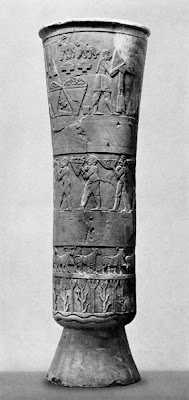Sumerian Art: The Warka Vase
provenience: Uruk
height: ca. 105; upper diam.: 36
material: stone (alabaster)
date: (ca. 3000 BC)
description:
vase, relief decoration in four registers, showing (bottom to top) rows of plants, sheep (make and female), nude males carrying baskets or jars, and a cultic scene, in which the ruler of city of Uruk delivers provisions to the temple of the goddess Inanna, represented here by two reed bundle standarts--symbols of the goddess--and a woman, probably her priestess ); rim broken; repair piece inserted in antiquity (holes drilled for repair)
status: stolen in April 2003, returned to museum in June 2003.
“The Warka Vase or the Uruk Vase is a carved alabaster stone vessel found in the temple complex of the Sumerian goddess Inanna in the ruins of the ancient city of Uruk, located in the modern Al Muthanna Governorate, in southern Iraq. Like the Narmer Palette from Egypt, it is one of the earliest surviving works of narrative relief sculpture, dated to c. 3,200–3000 BC. The vase was discovered as a collection of fragments by German Assyriologists in their sixth excavation season at Uruk in 1933/1934. It is named after the modern village of Warka - known as Uruk to the ancient Sumerians.”

image source: http://www.nyu.edu/classes/wright/Fall03/paper1images.html
The Warka Vase is one of the earliest examples of narrative art in Mesopotamia. In this regard it is compared to the relatively contemporary Narmer Palette of Egypt, a “founding” document of Egyptian Art.
The subject matter of the Warka Vase is the presentation of offerings to the goddess Inanna, a ritual enactment that may be associated with the idea of the Sacred Marriage, that is, the union of a God or a Goddess and a mortal, usually the ruler or a member of the ruling family; or the enactment of a marriage between the Gods assuming the forms of mortals, for instance, the royal couple, who may both represent and become in actuality, for a given function or period, the divinities they symbolize.
Modern studies of the Warka Vase have pointed out its nature as a “self-referential” or “performative” object, that is, the vase depicts a ritual of which it is itself an element, and depicts itself as such, as present in the ritual performance: a kind of meta-object in a meta-representation.
A formal affinity with the Narmer palette can be seen in the organization of the spatial elements and the visual narrative in bands or tiers. In the upper row, a pair of vases of the same form as the Warka Vase is depicted. Evidence suggests that the Warka Vase was itself one of a pair. Although of a fragmentary or inconclusive nature, the evidence for a pairing or duplication of the Warka Vase goes along with the many repetition of visual elements, forms and motifs in the vase: of animals and plants, of nude male figures carrying offers, etc. These repetitions point out to a symbolic and formal strategy of continuous multiplication or reproduction. The cylindrical form of the vase suggests an affinity to cylinder seals of general usage in Mesopotamia. In fact, some of the motifs of the Warka Vase, and the pair of vases of the same type, appear in later seals.
In Mesopotamian Art, nudity is generally presented as an expression of frailty and destitution, for instance, in the representation of enemies killed in battle, defeated and imprisoned or enslaved. In the Warka Vase, the nude figures are presented in a different context, and therefore with a different meaning and different expression. Here we may observe that the display of the naked human body in a religious context “anticipates”, so to speak, the role of the nude in Greek Art.
Container and contained, form and content, subject matter and representational strategies, product and processes, unite in the Warka Vase to underline its expressive and communicative dimension and the symbolic meaning of reproduction, fertility and abundance as gifts of the Goddess in return for the performance of ritual exchanges that ensure the reproduction of life and of society . In the Mesopotamian rituals, the intervention of the divinity is mediated by the ruler. Reproduction of life is always the reproduction of the social order.
Marcelo Guimaraes Lima






Comments